An Analysis of Blockchain Technology Applications in Higher Education
VerifiedAdded on 2023/04/21
|11
|2698
|281
Report
AI Summary
This report presents an annotated bibliography and self-evaluation on the uses of blockchain technology in higher education. The annotated bibliography synthesizes research from various authors, including Sharples and Domingue, Grech and Camilleri, and Turkanović et al., exploring applications such as secure educational record-keeping, decentralized credit systems, and digital credentialing. The sources highlight blockchain's potential to enhance transparency, improve data management, and foster trust within educational institutions. The self-evaluation likely reflects on the originality of the work, the understanding of the technology, and the ability to critically analyze the provided literature. The report emphasizes blockchain's disruptive potential, particularly in areas like online learning, student assessment, and the verification of qualifications. The analysis covers the challenges and opportunities associated with blockchain adoption in education, suggesting the technology's capacity to transform how educational data is managed and accessed.
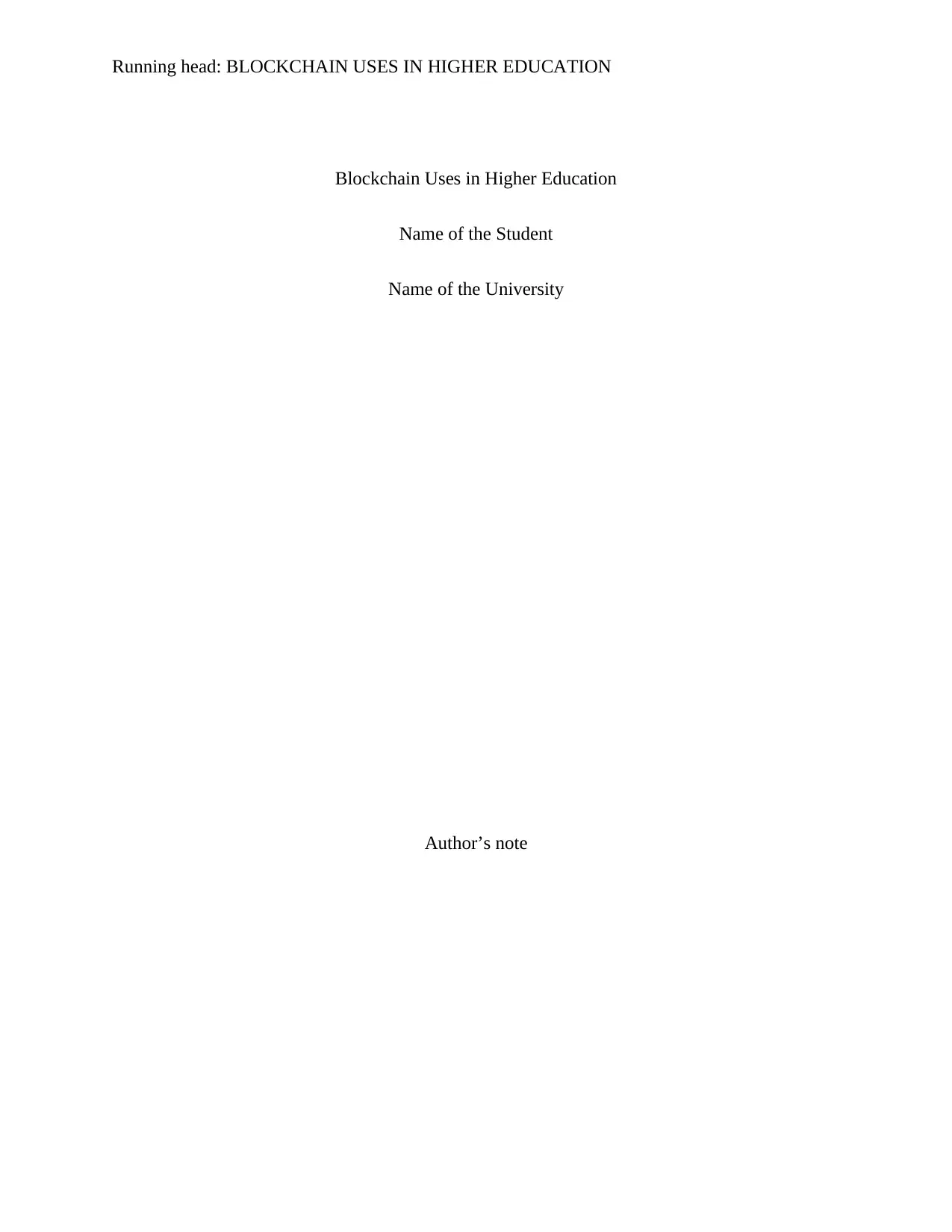
Running head: BLOCKCHAIN USES IN HIGHER EDUCATION
Blockchain Uses in Higher Education
Name of the Student
Name of the University
Author’s note
Blockchain Uses in Higher Education
Name of the Student
Name of the University
Author’s note
Paraphrase This Document
Need a fresh take? Get an instant paraphrase of this document with our AI Paraphraser
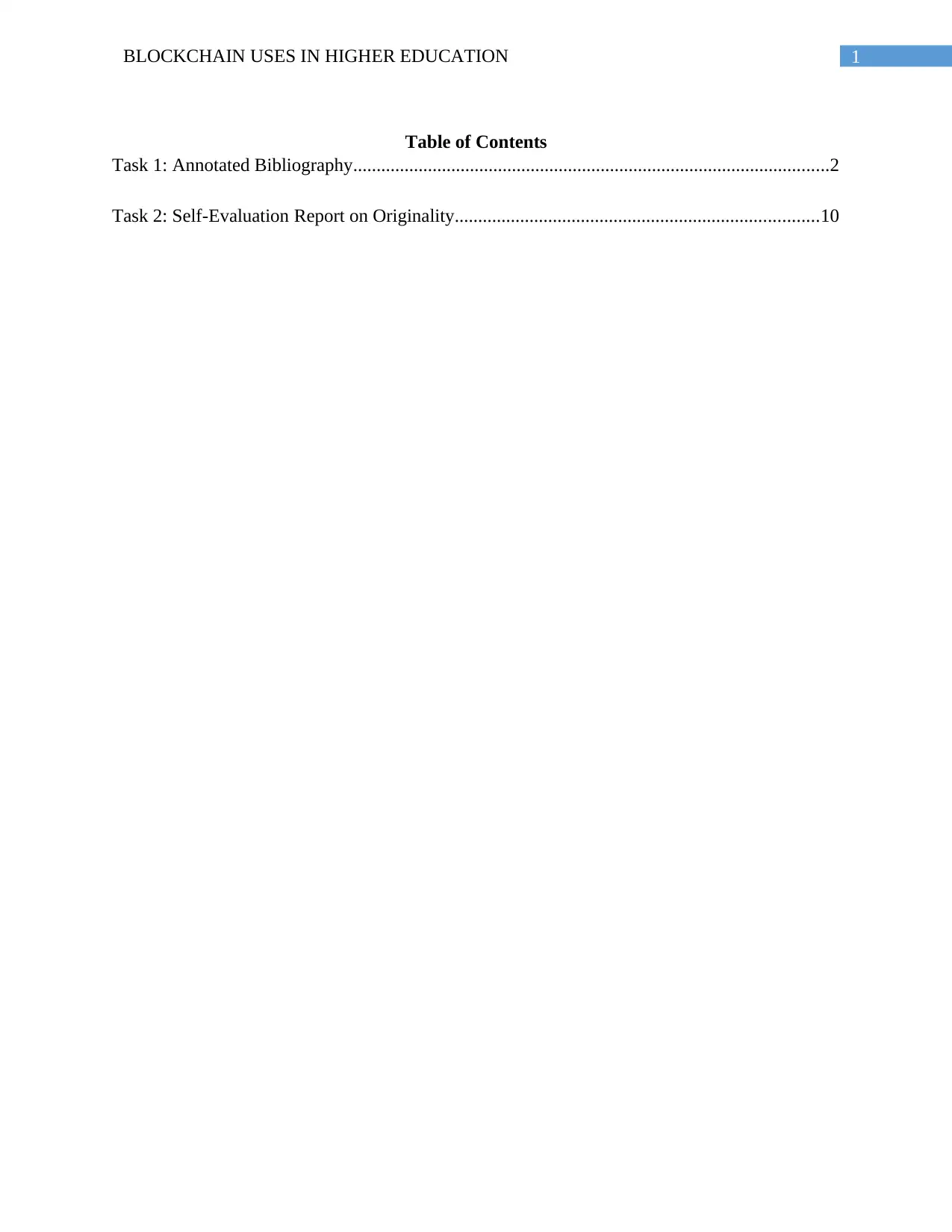
1BLOCKCHAIN USES IN HIGHER EDUCATION
Table of Contents
Task 1: Annotated Bibliography......................................................................................................2
Task 2: Self-Evaluation Report on Originality..............................................................................10
Table of Contents
Task 1: Annotated Bibliography......................................................................................................2
Task 2: Self-Evaluation Report on Originality..............................................................................10
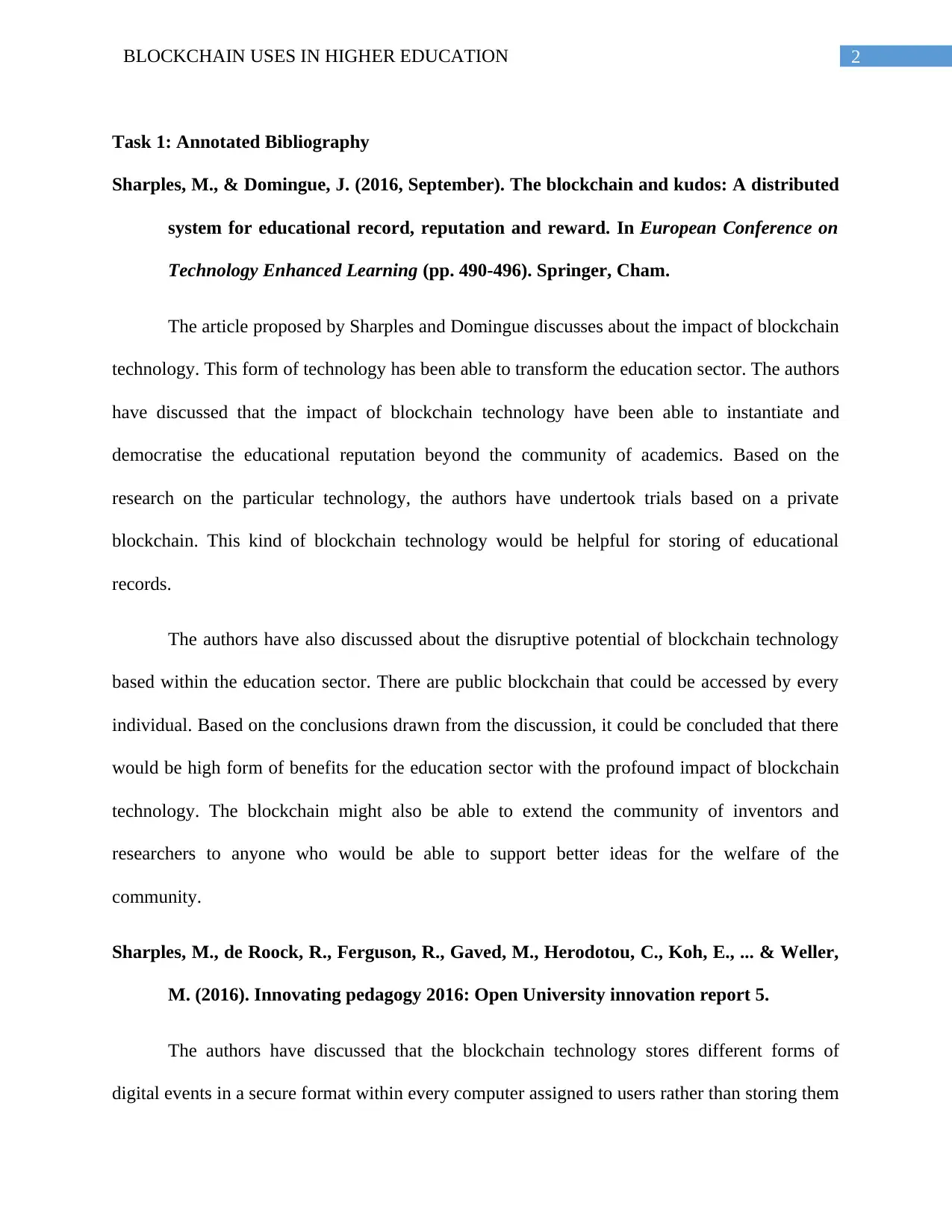
2BLOCKCHAIN USES IN HIGHER EDUCATION
Task 1: Annotated Bibliography
Sharples, M., & Domingue, J. (2016, September). The blockchain and kudos: A distributed
system for educational record, reputation and reward. In European Conference on
Technology Enhanced Learning (pp. 490-496). Springer, Cham.
The article proposed by Sharples and Domingue discusses about the impact of blockchain
technology. This form of technology has been able to transform the education sector. The authors
have discussed that the impact of blockchain technology have been able to instantiate and
democratise the educational reputation beyond the community of academics. Based on the
research on the particular technology, the authors have undertook trials based on a private
blockchain. This kind of blockchain technology would be helpful for storing of educational
records.
The authors have also discussed about the disruptive potential of blockchain technology
based within the education sector. There are public blockchain that could be accessed by every
individual. Based on the conclusions drawn from the discussion, it could be concluded that there
would be high form of benefits for the education sector with the profound impact of blockchain
technology. The blockchain might also be able to extend the community of inventors and
researchers to anyone who would be able to support better ideas for the welfare of the
community.
Sharples, M., de Roock, R., Ferguson, R., Gaved, M., Herodotou, C., Koh, E., ... & Weller,
M. (2016). Innovating pedagogy 2016: Open University innovation report 5.
The authors have discussed that the blockchain technology stores different forms of
digital events in a secure format within every computer assigned to users rather than storing them
Task 1: Annotated Bibliography
Sharples, M., & Domingue, J. (2016, September). The blockchain and kudos: A distributed
system for educational record, reputation and reward. In European Conference on
Technology Enhanced Learning (pp. 490-496). Springer, Cham.
The article proposed by Sharples and Domingue discusses about the impact of blockchain
technology. This form of technology has been able to transform the education sector. The authors
have discussed that the impact of blockchain technology have been able to instantiate and
democratise the educational reputation beyond the community of academics. Based on the
research on the particular technology, the authors have undertook trials based on a private
blockchain. This kind of blockchain technology would be helpful for storing of educational
records.
The authors have also discussed about the disruptive potential of blockchain technology
based within the education sector. There are public blockchain that could be accessed by every
individual. Based on the conclusions drawn from the discussion, it could be concluded that there
would be high form of benefits for the education sector with the profound impact of blockchain
technology. The blockchain might also be able to extend the community of inventors and
researchers to anyone who would be able to support better ideas for the welfare of the
community.
Sharples, M., de Roock, R., Ferguson, R., Gaved, M., Herodotou, C., Koh, E., ... & Weller,
M. (2016). Innovating pedagogy 2016: Open University innovation report 5.
The authors have discussed that the blockchain technology stores different forms of
digital events in a secure format within every computer assigned to users rather than storing them
⊘ This is a preview!⊘
Do you want full access?
Subscribe today to unlock all pages.

Trusted by 1+ million students worldwide
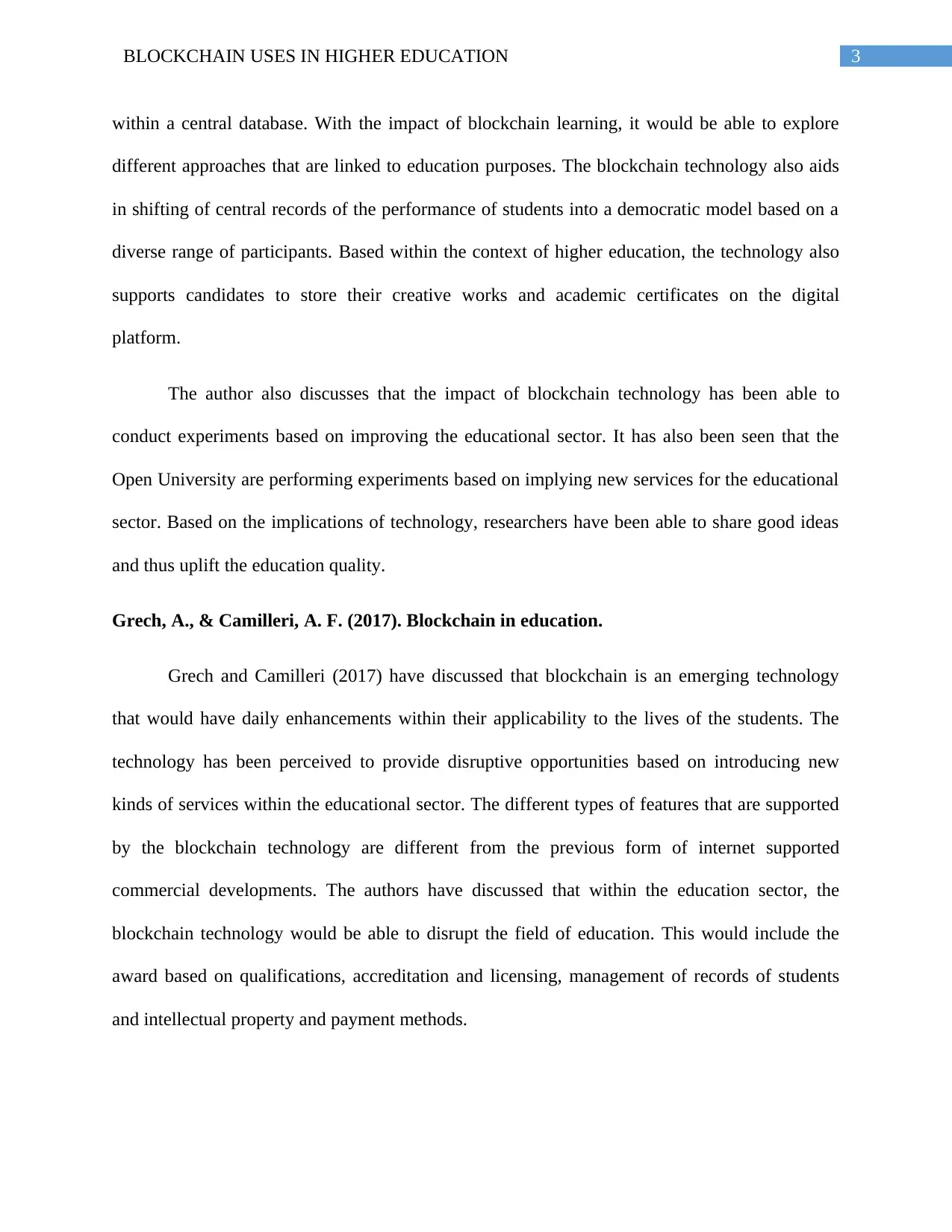
3BLOCKCHAIN USES IN HIGHER EDUCATION
within a central database. With the impact of blockchain learning, it would be able to explore
different approaches that are linked to education purposes. The blockchain technology also aids
in shifting of central records of the performance of students into a democratic model based on a
diverse range of participants. Based within the context of higher education, the technology also
supports candidates to store their creative works and academic certificates on the digital
platform.
The author also discusses that the impact of blockchain technology has been able to
conduct experiments based on improving the educational sector. It has also been seen that the
Open University are performing experiments based on implying new services for the educational
sector. Based on the implications of technology, researchers have been able to share good ideas
and thus uplift the education quality.
Grech, A., & Camilleri, A. F. (2017). Blockchain in education.
Grech and Camilleri (2017) have discussed that blockchain is an emerging technology
that would have daily enhancements within their applicability to the lives of the students. The
technology has been perceived to provide disruptive opportunities based on introducing new
kinds of services within the educational sector. The different types of features that are supported
by the blockchain technology are different from the previous form of internet supported
commercial developments. The authors have discussed that within the education sector, the
blockchain technology would be able to disrupt the field of education. This would include the
award based on qualifications, accreditation and licensing, management of records of students
and intellectual property and payment methods.
within a central database. With the impact of blockchain learning, it would be able to explore
different approaches that are linked to education purposes. The blockchain technology also aids
in shifting of central records of the performance of students into a democratic model based on a
diverse range of participants. Based within the context of higher education, the technology also
supports candidates to store their creative works and academic certificates on the digital
platform.
The author also discusses that the impact of blockchain technology has been able to
conduct experiments based on improving the educational sector. It has also been seen that the
Open University are performing experiments based on implying new services for the educational
sector. Based on the implications of technology, researchers have been able to share good ideas
and thus uplift the education quality.
Grech, A., & Camilleri, A. F. (2017). Blockchain in education.
Grech and Camilleri (2017) have discussed that blockchain is an emerging technology
that would have daily enhancements within their applicability to the lives of the students. The
technology has been perceived to provide disruptive opportunities based on introducing new
kinds of services within the educational sector. The different types of features that are supported
by the blockchain technology are different from the previous form of internet supported
commercial developments. The authors have discussed that within the education sector, the
blockchain technology would be able to disrupt the field of education. This would include the
award based on qualifications, accreditation and licensing, management of records of students
and intellectual property and payment methods.
Paraphrase This Document
Need a fresh take? Get an instant paraphrase of this document with our AI Paraphraser
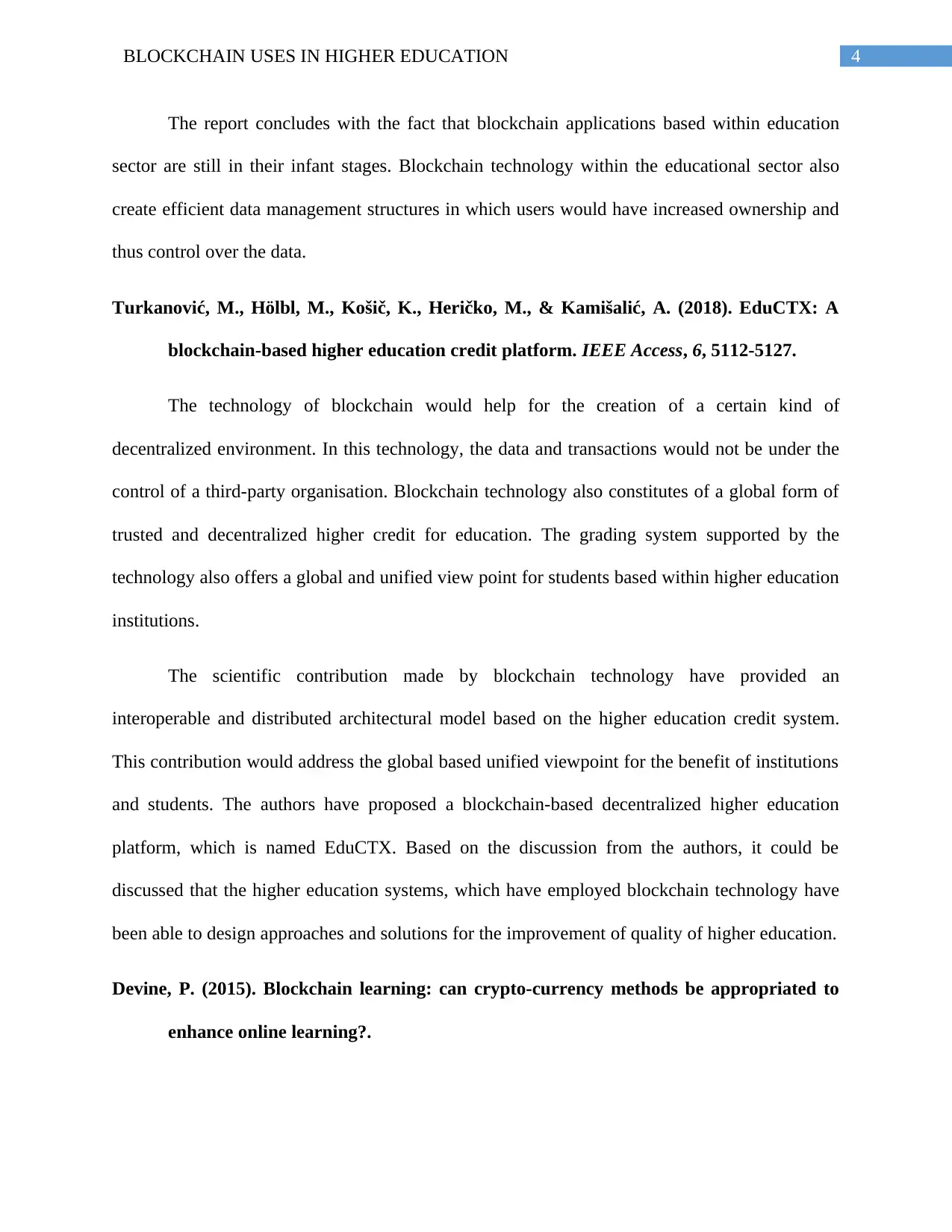
4BLOCKCHAIN USES IN HIGHER EDUCATION
The report concludes with the fact that blockchain applications based within education
sector are still in their infant stages. Blockchain technology within the educational sector also
create efficient data management structures in which users would have increased ownership and
thus control over the data.
Turkanović, M., Hölbl, M., Košič, K., Heričko, M., & Kamišalić, A. (2018). EduCTX: A
blockchain-based higher education credit platform. IEEE Access, 6, 5112-5127.
The technology of blockchain would help for the creation of a certain kind of
decentralized environment. In this technology, the data and transactions would not be under the
control of a third-party organisation. Blockchain technology also constitutes of a global form of
trusted and decentralized higher credit for education. The grading system supported by the
technology also offers a global and unified view point for students based within higher education
institutions.
The scientific contribution made by blockchain technology have provided an
interoperable and distributed architectural model based on the higher education credit system.
This contribution would address the global based unified viewpoint for the benefit of institutions
and students. The authors have proposed a blockchain-based decentralized higher education
platform, which is named EduCTX. Based on the discussion from the authors, it could be
discussed that the higher education systems, which have employed blockchain technology have
been able to design approaches and solutions for the improvement of quality of higher education.
Devine, P. (2015). Blockchain learning: can crypto-currency methods be appropriated to
enhance online learning?.
The report concludes with the fact that blockchain applications based within education
sector are still in their infant stages. Blockchain technology within the educational sector also
create efficient data management structures in which users would have increased ownership and
thus control over the data.
Turkanović, M., Hölbl, M., Košič, K., Heričko, M., & Kamišalić, A. (2018). EduCTX: A
blockchain-based higher education credit platform. IEEE Access, 6, 5112-5127.
The technology of blockchain would help for the creation of a certain kind of
decentralized environment. In this technology, the data and transactions would not be under the
control of a third-party organisation. Blockchain technology also constitutes of a global form of
trusted and decentralized higher credit for education. The grading system supported by the
technology also offers a global and unified view point for students based within higher education
institutions.
The scientific contribution made by blockchain technology have provided an
interoperable and distributed architectural model based on the higher education credit system.
This contribution would address the global based unified viewpoint for the benefit of institutions
and students. The authors have proposed a blockchain-based decentralized higher education
platform, which is named EduCTX. Based on the discussion from the authors, it could be
discussed that the higher education systems, which have employed blockchain technology have
been able to design approaches and solutions for the improvement of quality of higher education.
Devine, P. (2015). Blockchain learning: can crypto-currency methods be appropriated to
enhance online learning?.
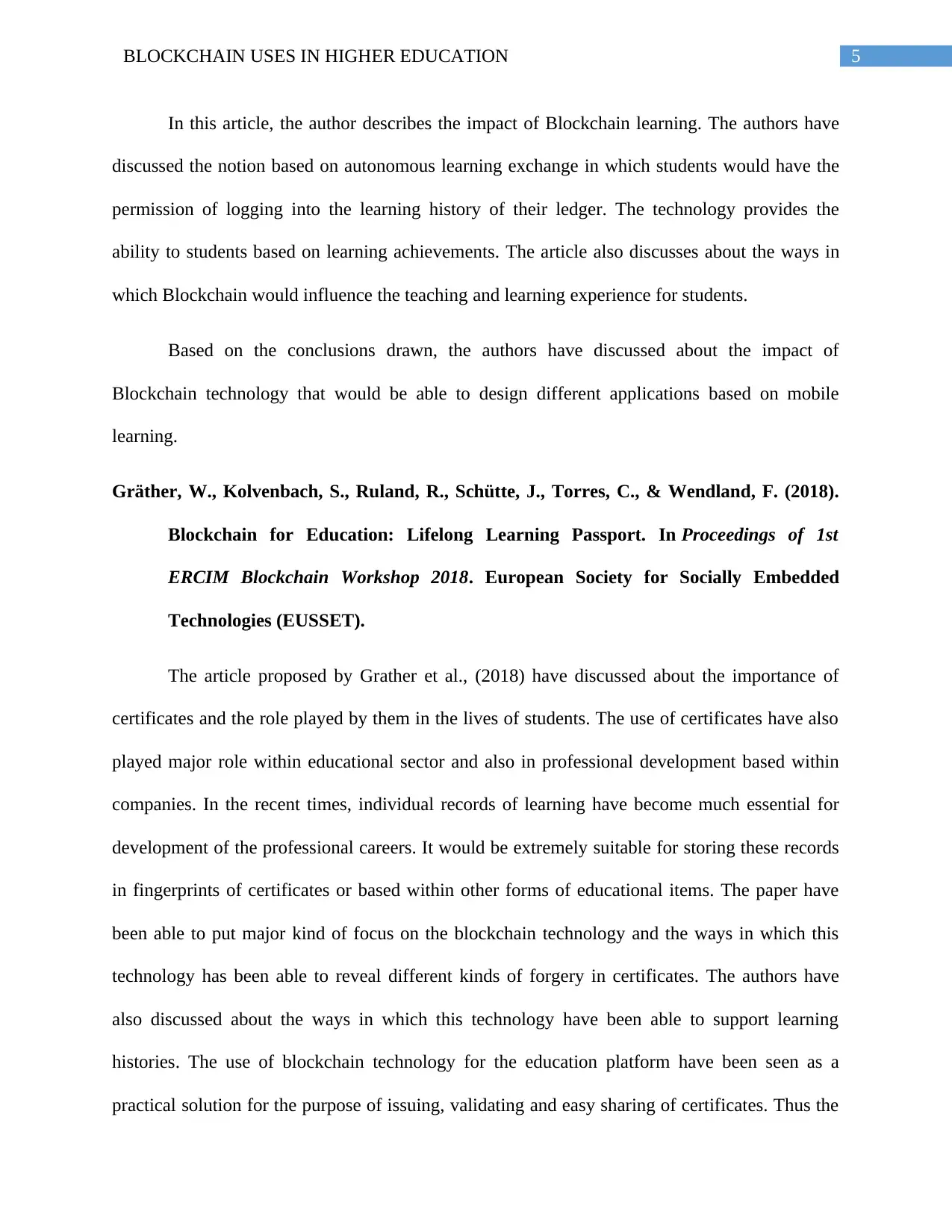
5BLOCKCHAIN USES IN HIGHER EDUCATION
In this article, the author describes the impact of Blockchain learning. The authors have
discussed the notion based on autonomous learning exchange in which students would have the
permission of logging into the learning history of their ledger. The technology provides the
ability to students based on learning achievements. The article also discusses about the ways in
which Blockchain would influence the teaching and learning experience for students.
Based on the conclusions drawn, the authors have discussed about the impact of
Blockchain technology that would be able to design different applications based on mobile
learning.
Gräther, W., Kolvenbach, S., Ruland, R., Schütte, J., Torres, C., & Wendland, F. (2018).
Blockchain for Education: Lifelong Learning Passport. In Proceedings of 1st
ERCIM Blockchain Workshop 2018. European Society for Socially Embedded
Technologies (EUSSET).
The article proposed by Grather et al., (2018) have discussed about the importance of
certificates and the role played by them in the lives of students. The use of certificates have also
played major role within educational sector and also in professional development based within
companies. In the recent times, individual records of learning have become much essential for
development of the professional careers. It would be extremely suitable for storing these records
in fingerprints of certificates or based within other forms of educational items. The paper have
been able to put major kind of focus on the blockchain technology and the ways in which this
technology has been able to reveal different kinds of forgery in certificates. The authors have
also discussed about the ways in which this technology have been able to support learning
histories. The use of blockchain technology for the education platform have been seen as a
practical solution for the purpose of issuing, validating and easy sharing of certificates. Thus the
In this article, the author describes the impact of Blockchain learning. The authors have
discussed the notion based on autonomous learning exchange in which students would have the
permission of logging into the learning history of their ledger. The technology provides the
ability to students based on learning achievements. The article also discusses about the ways in
which Blockchain would influence the teaching and learning experience for students.
Based on the conclusions drawn, the authors have discussed about the impact of
Blockchain technology that would be able to design different applications based on mobile
learning.
Gräther, W., Kolvenbach, S., Ruland, R., Schütte, J., Torres, C., & Wendland, F. (2018).
Blockchain for Education: Lifelong Learning Passport. In Proceedings of 1st
ERCIM Blockchain Workshop 2018. European Society for Socially Embedded
Technologies (EUSSET).
The article proposed by Grather et al., (2018) have discussed about the importance of
certificates and the role played by them in the lives of students. The use of certificates have also
played major role within educational sector and also in professional development based within
companies. In the recent times, individual records of learning have become much essential for
development of the professional careers. It would be extremely suitable for storing these records
in fingerprints of certificates or based within other forms of educational items. The paper have
been able to put major kind of focus on the blockchain technology and the ways in which this
technology has been able to reveal different kinds of forgery in certificates. The authors have
also discussed about the ways in which this technology have been able to support learning
histories. The use of blockchain technology for the education platform have been seen as a
practical solution for the purpose of issuing, validating and easy sharing of certificates. Thus the
⊘ This is a preview!⊘
Do you want full access?
Subscribe today to unlock all pages.

Trusted by 1+ million students worldwide
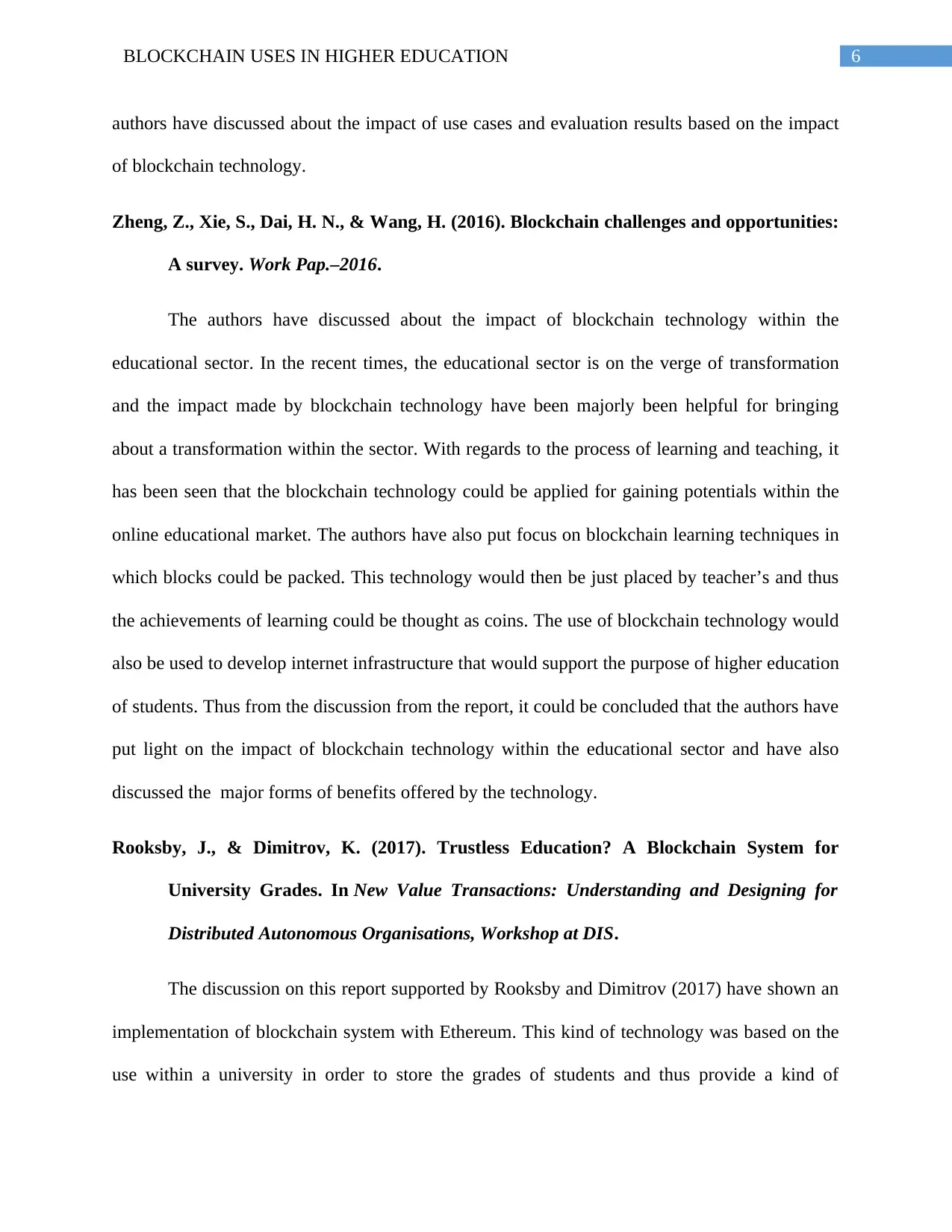
6BLOCKCHAIN USES IN HIGHER EDUCATION
authors have discussed about the impact of use cases and evaluation results based on the impact
of blockchain technology.
Zheng, Z., Xie, S., Dai, H. N., & Wang, H. (2016). Blockchain challenges and opportunities:
A survey. Work Pap.–2016.
The authors have discussed about the impact of blockchain technology within the
educational sector. In the recent times, the educational sector is on the verge of transformation
and the impact made by blockchain technology have been majorly been helpful for bringing
about a transformation within the sector. With regards to the process of learning and teaching, it
has been seen that the blockchain technology could be applied for gaining potentials within the
online educational market. The authors have also put focus on blockchain learning techniques in
which blocks could be packed. This technology would then be just placed by teacher’s and thus
the achievements of learning could be thought as coins. The use of blockchain technology would
also be used to develop internet infrastructure that would support the purpose of higher education
of students. Thus from the discussion from the report, it could be concluded that the authors have
put light on the impact of blockchain technology within the educational sector and have also
discussed the major forms of benefits offered by the technology.
Rooksby, J., & Dimitrov, K. (2017). Trustless Education? A Blockchain System for
University Grades. In New Value Transactions: Understanding and Designing for
Distributed Autonomous Organisations, Workshop at DIS.
The discussion on this report supported by Rooksby and Dimitrov (2017) have shown an
implementation of blockchain system with Ethereum. This kind of technology was based on the
use within a university in order to store the grades of students and thus provide a kind of
authors have discussed about the impact of use cases and evaluation results based on the impact
of blockchain technology.
Zheng, Z., Xie, S., Dai, H. N., & Wang, H. (2016). Blockchain challenges and opportunities:
A survey. Work Pap.–2016.
The authors have discussed about the impact of blockchain technology within the
educational sector. In the recent times, the educational sector is on the verge of transformation
and the impact made by blockchain technology have been majorly been helpful for bringing
about a transformation within the sector. With regards to the process of learning and teaching, it
has been seen that the blockchain technology could be applied for gaining potentials within the
online educational market. The authors have also put focus on blockchain learning techniques in
which blocks could be packed. This technology would then be just placed by teacher’s and thus
the achievements of learning could be thought as coins. The use of blockchain technology would
also be used to develop internet infrastructure that would support the purpose of higher education
of students. Thus from the discussion from the report, it could be concluded that the authors have
put light on the impact of blockchain technology within the educational sector and have also
discussed the major forms of benefits offered by the technology.
Rooksby, J., & Dimitrov, K. (2017). Trustless Education? A Blockchain System for
University Grades. In New Value Transactions: Understanding and Designing for
Distributed Autonomous Organisations, Workshop at DIS.
The discussion on this report supported by Rooksby and Dimitrov (2017) have shown an
implementation of blockchain system with Ethereum. This kind of technology was based on the
use within a university in order to store the grades of students and thus provide a kind of
Paraphrase This Document
Need a fresh take? Get an instant paraphrase of this document with our AI Paraphraser
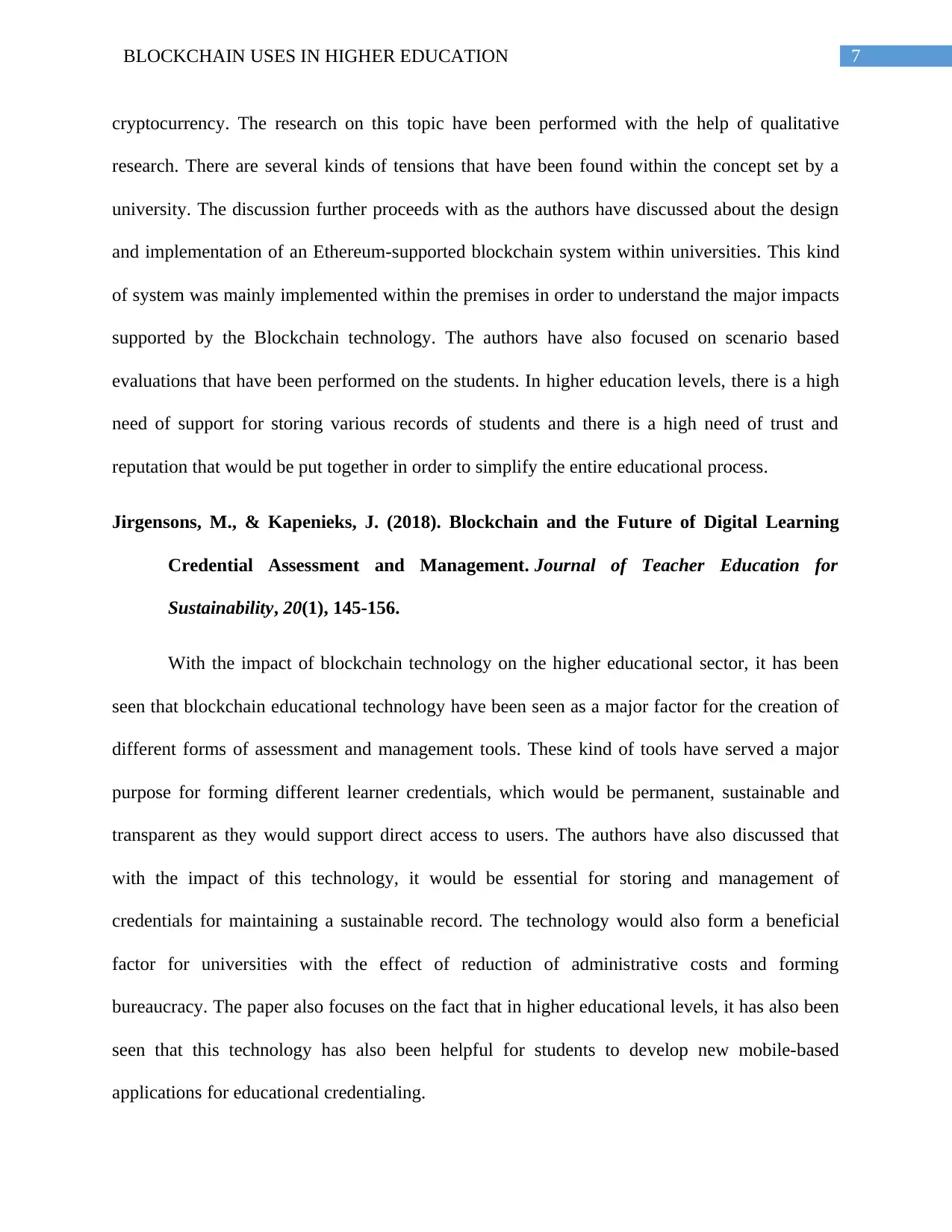
7BLOCKCHAIN USES IN HIGHER EDUCATION
cryptocurrency. The research on this topic have been performed with the help of qualitative
research. There are several kinds of tensions that have been found within the concept set by a
university. The discussion further proceeds with as the authors have discussed about the design
and implementation of an Ethereum-supported blockchain system within universities. This kind
of system was mainly implemented within the premises in order to understand the major impacts
supported by the Blockchain technology. The authors have also focused on scenario based
evaluations that have been performed on the students. In higher education levels, there is a high
need of support for storing various records of students and there is a high need of trust and
reputation that would be put together in order to simplify the entire educational process.
Jirgensons, M., & Kapenieks, J. (2018). Blockchain and the Future of Digital Learning
Credential Assessment and Management. Journal of Teacher Education for
Sustainability, 20(1), 145-156.
With the impact of blockchain technology on the higher educational sector, it has been
seen that blockchain educational technology have been seen as a major factor for the creation of
different forms of assessment and management tools. These kind of tools have served a major
purpose for forming different learner credentials, which would be permanent, sustainable and
transparent as they would support direct access to users. The authors have also discussed that
with the impact of this technology, it would be essential for storing and management of
credentials for maintaining a sustainable record. The technology would also form a beneficial
factor for universities with the effect of reduction of administrative costs and forming
bureaucracy. The paper also focuses on the fact that in higher educational levels, it has also been
seen that this technology has also been helpful for students to develop new mobile-based
applications for educational credentialing.
cryptocurrency. The research on this topic have been performed with the help of qualitative
research. There are several kinds of tensions that have been found within the concept set by a
university. The discussion further proceeds with as the authors have discussed about the design
and implementation of an Ethereum-supported blockchain system within universities. This kind
of system was mainly implemented within the premises in order to understand the major impacts
supported by the Blockchain technology. The authors have also focused on scenario based
evaluations that have been performed on the students. In higher education levels, there is a high
need of support for storing various records of students and there is a high need of trust and
reputation that would be put together in order to simplify the entire educational process.
Jirgensons, M., & Kapenieks, J. (2018). Blockchain and the Future of Digital Learning
Credential Assessment and Management. Journal of Teacher Education for
Sustainability, 20(1), 145-156.
With the impact of blockchain technology on the higher educational sector, it has been
seen that blockchain educational technology have been seen as a major factor for the creation of
different forms of assessment and management tools. These kind of tools have served a major
purpose for forming different learner credentials, which would be permanent, sustainable and
transparent as they would support direct access to users. The authors have also discussed that
with the impact of this technology, it would be essential for storing and management of
credentials for maintaining a sustainable record. The technology would also form a beneficial
factor for universities with the effect of reduction of administrative costs and forming
bureaucracy. The paper also focuses on the fact that in higher educational levels, it has also been
seen that this technology has also been helpful for students to develop new mobile-based
applications for educational credentialing.
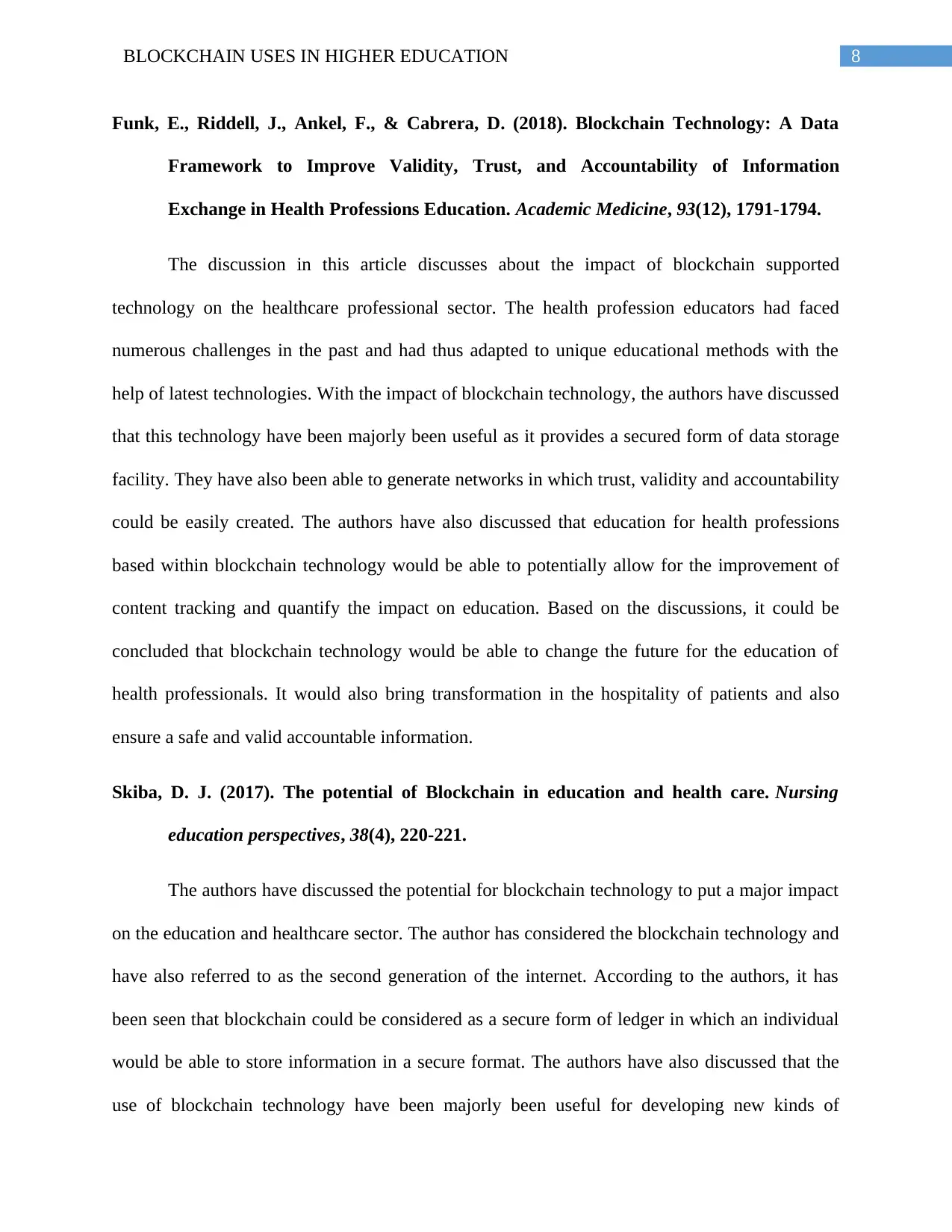
8BLOCKCHAIN USES IN HIGHER EDUCATION
Funk, E., Riddell, J., Ankel, F., & Cabrera, D. (2018). Blockchain Technology: A Data
Framework to Improve Validity, Trust, and Accountability of Information
Exchange in Health Professions Education. Academic Medicine, 93(12), 1791-1794.
The discussion in this article discusses about the impact of blockchain supported
technology on the healthcare professional sector. The health profession educators had faced
numerous challenges in the past and had thus adapted to unique educational methods with the
help of latest technologies. With the impact of blockchain technology, the authors have discussed
that this technology have been majorly been useful as it provides a secured form of data storage
facility. They have also been able to generate networks in which trust, validity and accountability
could be easily created. The authors have also discussed that education for health professions
based within blockchain technology would be able to potentially allow for the improvement of
content tracking and quantify the impact on education. Based on the discussions, it could be
concluded that blockchain technology would be able to change the future for the education of
health professionals. It would also bring transformation in the hospitality of patients and also
ensure a safe and valid accountable information.
Skiba, D. J. (2017). The potential of Blockchain in education and health care. Nursing
education perspectives, 38(4), 220-221.
The authors have discussed the potential for blockchain technology to put a major impact
on the education and healthcare sector. The author has considered the blockchain technology and
have also referred to as the second generation of the internet. According to the authors, it has
been seen that blockchain could be considered as a secure form of ledger in which an individual
would be able to store information in a secure format. The authors have also discussed that the
use of blockchain technology have been majorly been useful for developing new kinds of
Funk, E., Riddell, J., Ankel, F., & Cabrera, D. (2018). Blockchain Technology: A Data
Framework to Improve Validity, Trust, and Accountability of Information
Exchange in Health Professions Education. Academic Medicine, 93(12), 1791-1794.
The discussion in this article discusses about the impact of blockchain supported
technology on the healthcare professional sector. The health profession educators had faced
numerous challenges in the past and had thus adapted to unique educational methods with the
help of latest technologies. With the impact of blockchain technology, the authors have discussed
that this technology have been majorly been useful as it provides a secured form of data storage
facility. They have also been able to generate networks in which trust, validity and accountability
could be easily created. The authors have also discussed that education for health professions
based within blockchain technology would be able to potentially allow for the improvement of
content tracking and quantify the impact on education. Based on the discussions, it could be
concluded that blockchain technology would be able to change the future for the education of
health professionals. It would also bring transformation in the hospitality of patients and also
ensure a safe and valid accountable information.
Skiba, D. J. (2017). The potential of Blockchain in education and health care. Nursing
education perspectives, 38(4), 220-221.
The authors have discussed the potential for blockchain technology to put a major impact
on the education and healthcare sector. The author has considered the blockchain technology and
have also referred to as the second generation of the internet. According to the authors, it has
been seen that blockchain could be considered as a secure form of ledger in which an individual
would be able to store information in a secure format. The authors have also discussed that the
use of blockchain technology have been majorly been useful for developing new kinds of
⊘ This is a preview!⊘
Do you want full access?
Subscribe today to unlock all pages.

Trusted by 1+ million students worldwide
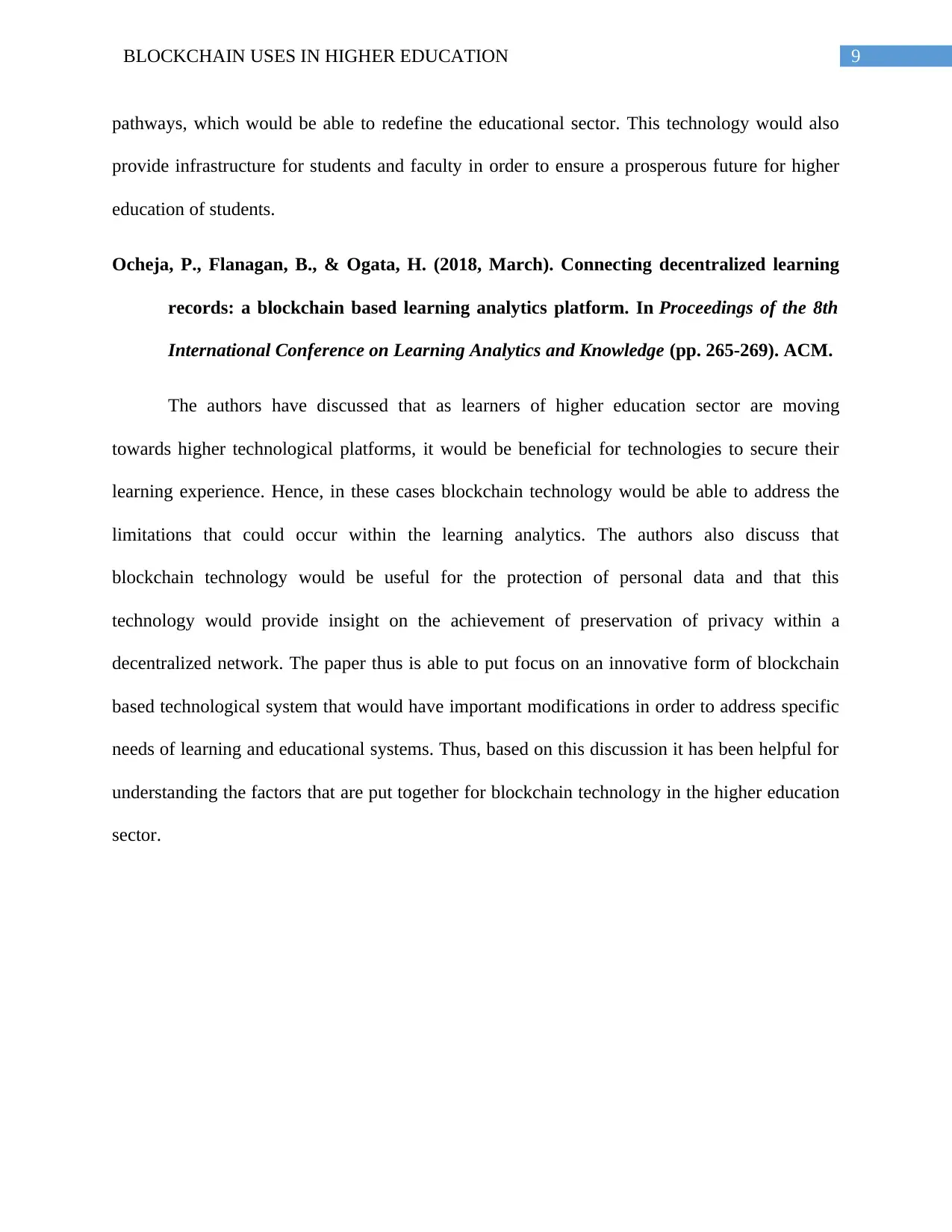
9BLOCKCHAIN USES IN HIGHER EDUCATION
pathways, which would be able to redefine the educational sector. This technology would also
provide infrastructure for students and faculty in order to ensure a prosperous future for higher
education of students.
Ocheja, P., Flanagan, B., & Ogata, H. (2018, March). Connecting decentralized learning
records: a blockchain based learning analytics platform. In Proceedings of the 8th
International Conference on Learning Analytics and Knowledge (pp. 265-269). ACM.
The authors have discussed that as learners of higher education sector are moving
towards higher technological platforms, it would be beneficial for technologies to secure their
learning experience. Hence, in these cases blockchain technology would be able to address the
limitations that could occur within the learning analytics. The authors also discuss that
blockchain technology would be useful for the protection of personal data and that this
technology would provide insight on the achievement of preservation of privacy within a
decentralized network. The paper thus is able to put focus on an innovative form of blockchain
based technological system that would have important modifications in order to address specific
needs of learning and educational systems. Thus, based on this discussion it has been helpful for
understanding the factors that are put together for blockchain technology in the higher education
sector.
pathways, which would be able to redefine the educational sector. This technology would also
provide infrastructure for students and faculty in order to ensure a prosperous future for higher
education of students.
Ocheja, P., Flanagan, B., & Ogata, H. (2018, March). Connecting decentralized learning
records: a blockchain based learning analytics platform. In Proceedings of the 8th
International Conference on Learning Analytics and Knowledge (pp. 265-269). ACM.
The authors have discussed that as learners of higher education sector are moving
towards higher technological platforms, it would be beneficial for technologies to secure their
learning experience. Hence, in these cases blockchain technology would be able to address the
limitations that could occur within the learning analytics. The authors also discuss that
blockchain technology would be useful for the protection of personal data and that this
technology would provide insight on the achievement of preservation of privacy within a
decentralized network. The paper thus is able to put focus on an innovative form of blockchain
based technological system that would have important modifications in order to address specific
needs of learning and educational systems. Thus, based on this discussion it has been helpful for
understanding the factors that are put together for blockchain technology in the higher education
sector.
Paraphrase This Document
Need a fresh take? Get an instant paraphrase of this document with our AI Paraphraser
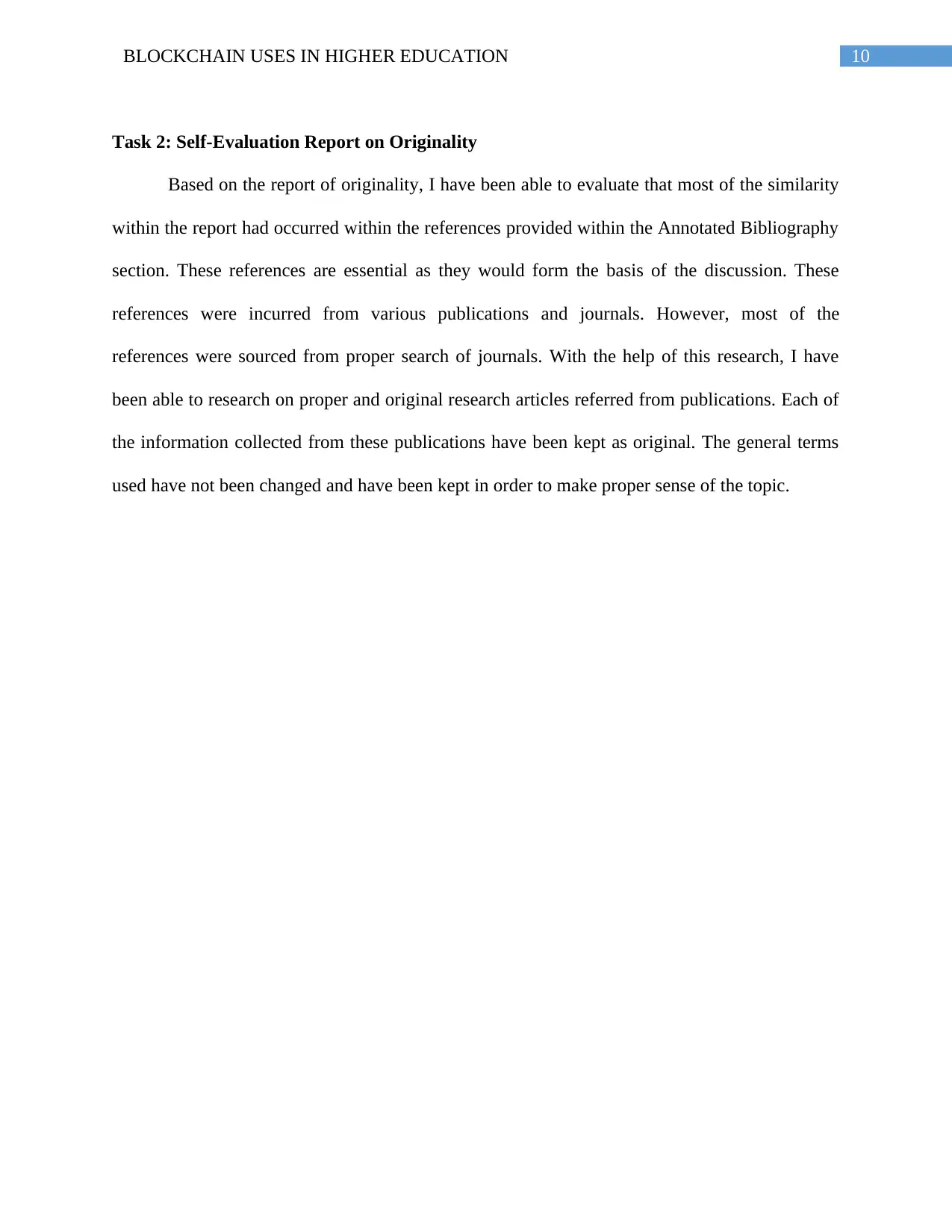
10BLOCKCHAIN USES IN HIGHER EDUCATION
Task 2: Self-Evaluation Report on Originality
Based on the report of originality, I have been able to evaluate that most of the similarity
within the report had occurred within the references provided within the Annotated Bibliography
section. These references are essential as they would form the basis of the discussion. These
references were incurred from various publications and journals. However, most of the
references were sourced from proper search of journals. With the help of this research, I have
been able to research on proper and original research articles referred from publications. Each of
the information collected from these publications have been kept as original. The general terms
used have not been changed and have been kept in order to make proper sense of the topic.
Task 2: Self-Evaluation Report on Originality
Based on the report of originality, I have been able to evaluate that most of the similarity
within the report had occurred within the references provided within the Annotated Bibliography
section. These references are essential as they would form the basis of the discussion. These
references were incurred from various publications and journals. However, most of the
references were sourced from proper search of journals. With the help of this research, I have
been able to research on proper and original research articles referred from publications. Each of
the information collected from these publications have been kept as original. The general terms
used have not been changed and have been kept in order to make proper sense of the topic.
1 out of 11
Related Documents
Your All-in-One AI-Powered Toolkit for Academic Success.
+13062052269
info@desklib.com
Available 24*7 on WhatsApp / Email
![[object Object]](/_next/static/media/star-bottom.7253800d.svg)
Unlock your academic potential
Copyright © 2020–2025 A2Z Services. All Rights Reserved. Developed and managed by ZUCOL.




